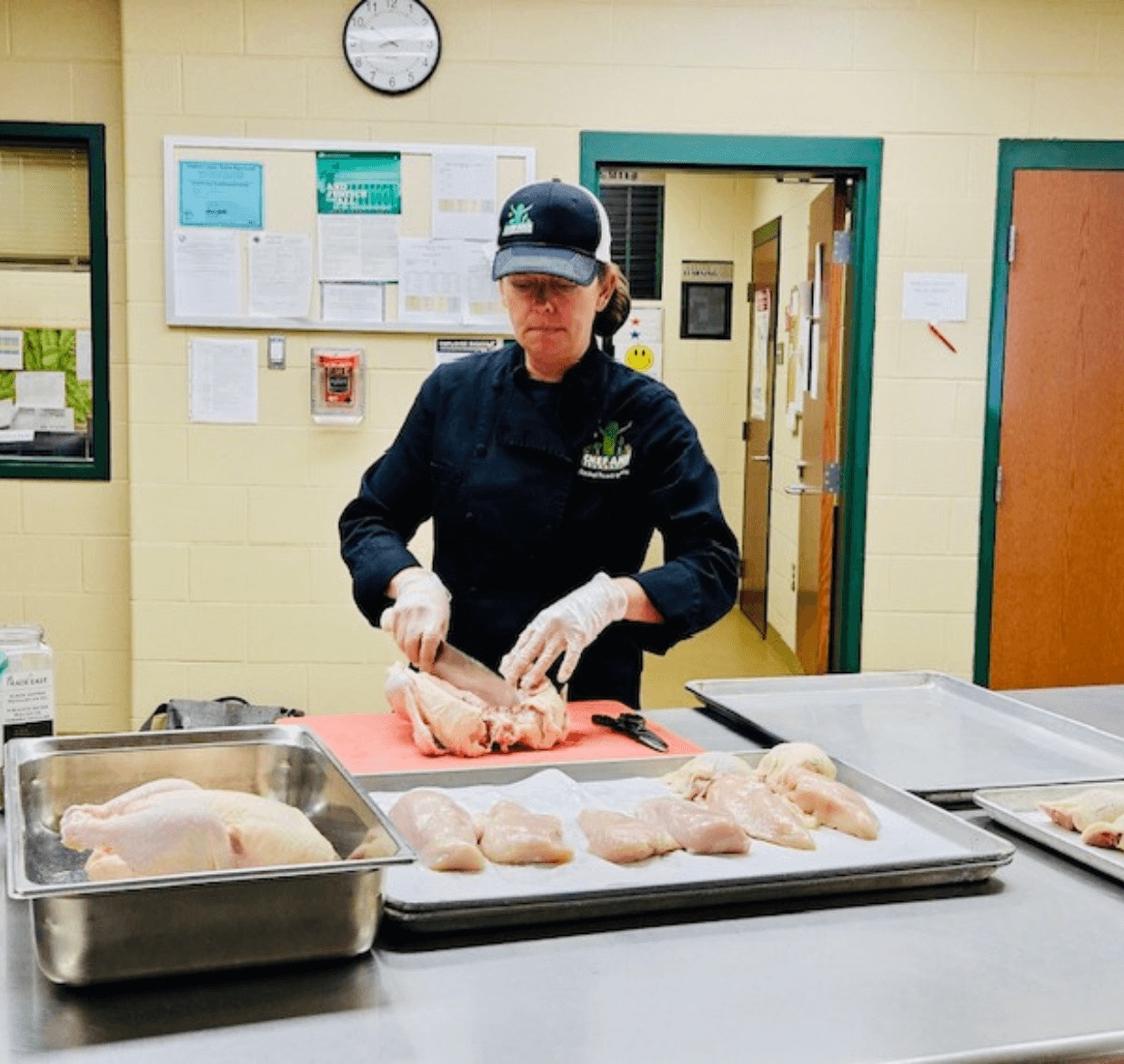
Fresh Animal Proteins
Adding fresh animal proteins to the menu in a school food program can lead to several positive outcomes. Using raw proteins makes dishes taste better, there can be health benefits, and if purchased locally, there are significant benefits for the local economy. It’s also a great way to educate students about the benefits of high-quality, local protein.
Proper training on food safety and cooking procedures is an important step prior to adding fresh animal protein to the menu. This page is designed to help ensure your school food program safely and successfully adds fresh animal proteins.

Fresh Animal Proteins
Adding fresh animal proteins to the menu in a school food program can lead to several positive outcomes. Using raw proteins makes dishes taste better, there can be health benefits, and if purchased locally, there are significant benefits for the local economy. It’s also a great way to educate students about the benefits of high-quality, local protein.
Proper training on food safety and cooking procedures is an important step prior to adding fresh animal protein to the menu. This page is designed to help ensure your school food program safely and successfully adds fresh animal proteins.
This page offers resources and guidance for each step when working with fresh, raw animal proteins in a school production setting including purchasing and receiving fresh proteins, checking products for quality and freshness, safe food handling, proper thawing methods, cooking procedures, as well as cooling procedures.
Purchasing
Purchase raw protein only from suppliers who get their products from reputable farms and ranches and use meat packers who are USDA inspected. Take time to visit or get a tour of the land where the animals are raised. That helps ensure the farmer or rancher is taking care of the animals as advertised and that the quality and standards are evident.
You can also visit the meat packer to ensure that they maintain clean warehouses and packing facilities. Ask the following questions to ensure standards are being met:
- Do they have a HACCP program? Is the USDA inspector there?
- Does the meat packer deliver from their facility with their own trucks? If so, observe the delivery vehicles to ensure that they are clean and temperature is maintained.
- Do they go through a prime vendor for delivery? If so, who?
- Check available delivery times with vendors/suppliers to ensure that deliveries are made at a time that your school food program can check and store the products immediately.
Visit our Procurement Page for more information and support on purchasing products that support a scratch-cooked program.
Receiving
Products must meet specifications and quality requirements. If any foods are deemed unacceptable, they should be rejected and put in a designated area for credit. Receive only one delivery at a time from approved suppliers. Check the temperature of the items first.
Frozen products should be fully frozen without signs of defrosting. Refrigerated products should not be above 41°F. Reject potentially hazardous foods that are not at an acceptable temperature.
Evaluate the quality of products by smell, sight, and touch.
Color changes are normal for fresh products. With spoilage, there can be a color change—often a fading or darkening. However, it is important to note that change in color alone does not mean the product is spoiled. In addition to the color change, the meat or poultry will have an “off” odor. Touch the product to see if it is sticky or tacky to the touch, or it may be slimy. If raw protein has these characteristics, do not use it.
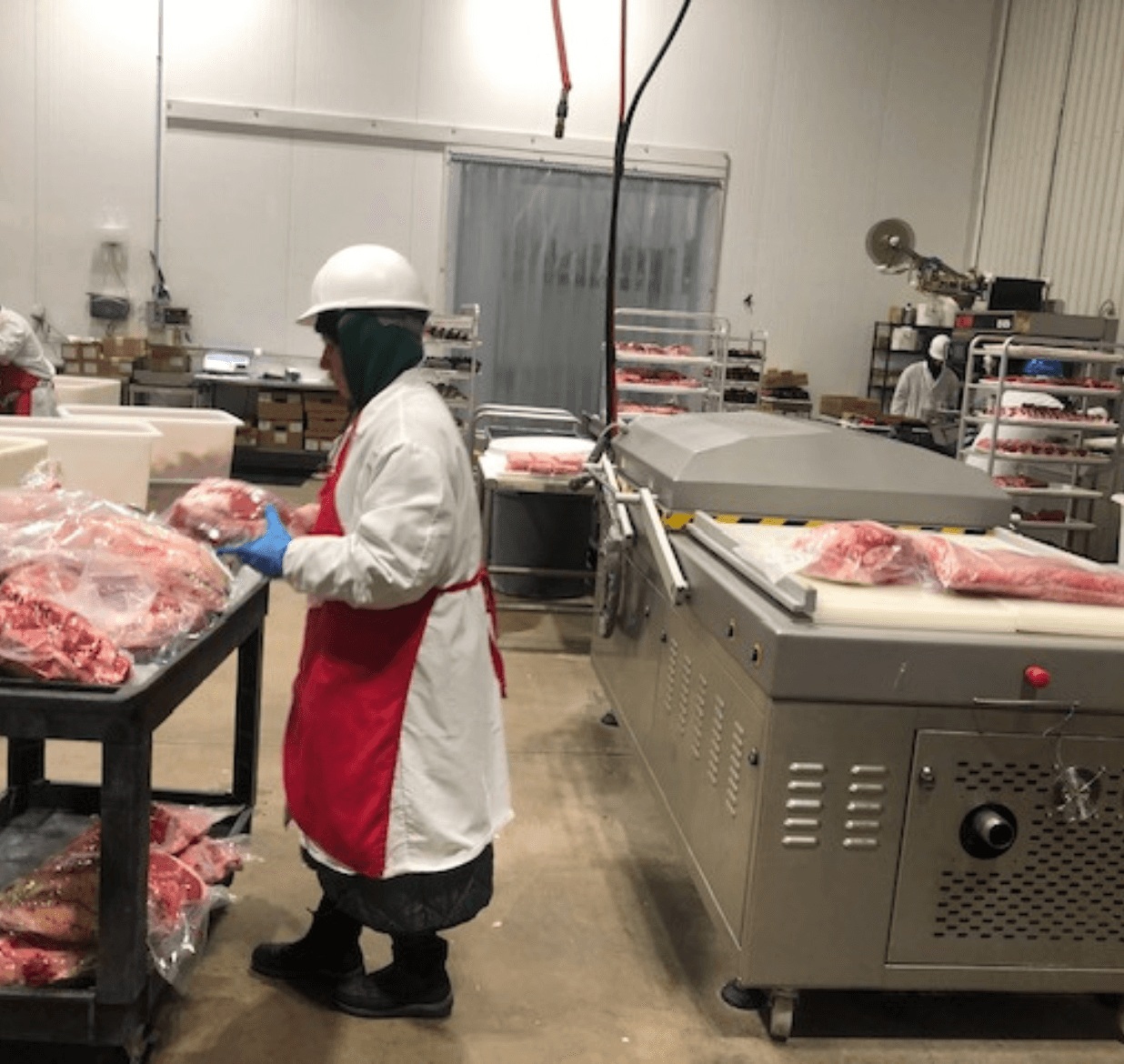

Receiving
Products must meet specifications and quality requirements. If any foods are deemed unacceptable, they should be rejected and put in a designated area for credit. Receive only one delivery at a time from approved suppliers. Check the temperature of the items first.
Frozen products should be fully frozen without signs of defrosting. Refrigerated products should not be above 41°F. Reject potentially hazardous foods that are not at an acceptable temperature.
Evaluate the quality of products by smell, sight, and touch.
Color changes are normal for fresh products. With spoilage, there can be a color change—often a fading or darkening. However, it is important to note that change in color alone does not mean the product is spoiled. In addition to the color change, the meat or poultry will have an “off” odor. Touch the product to see if it is sticky or tacky to the touch, or it may be slimy. If raw protein has these characteristics, do not use it.
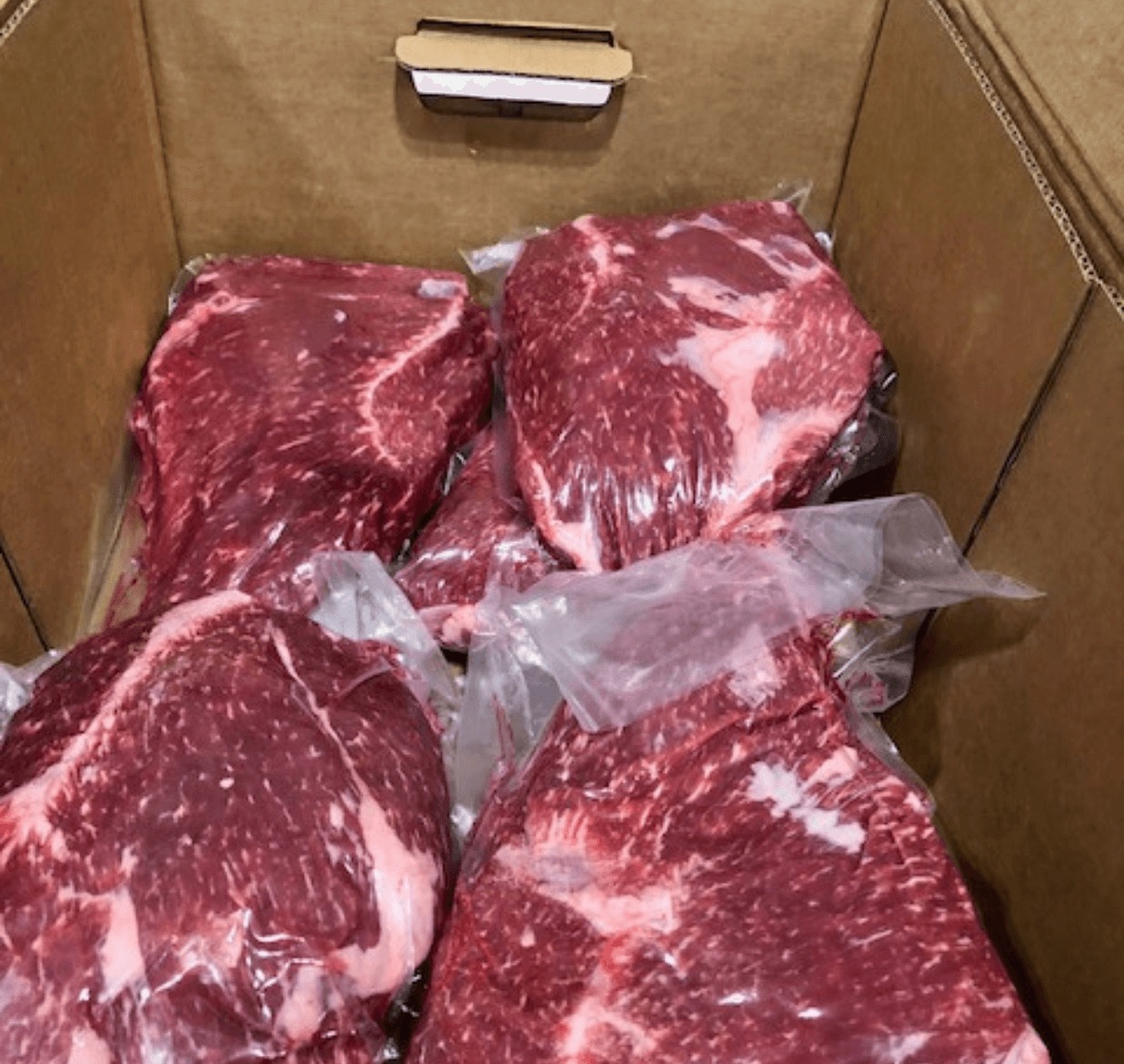
If products are frozen, make sure it is completely solid and do not show evidence of thawing and refreezing. Color changes in frozen foods occur just as they do in the refrigerated food. Fading and darkening, for example, do not affect their safety. These changes are minimized by using freezer-type wrapping and by expelling as much air as possible from the package.
White dried patches indicate freezer burn. When meat and poultry have been frozen for an extended period or have not been wrapped and sealed properly, freezer burn will occur. The product remains safe to eat, but the areas with freezer burn will be dried out and tasteless. Those areas can be trimmed away if desired.

If products are frozen, make sure it is completely solid and do not show evidence of thawing and refreezing. Color changes in frozen foods occur just as they do in the refrigerated food. Fading and darkening, for example, do not affect their safety. These changes are minimized by using freezer-type wrapping and by expelling as much air as possible from the package.
White dried patches indicate freezer burn. When meat and poultry have been frozen for an extended period or have not been wrapped and sealed properly, freezer burn will occur. The product remains safe to eat, but the areas with freezer burn will be dried out and tasteless. Those areas can be trimmed away if desired.
Reject all foods that are delivered above 41°F. The danger zone for bacterial growth in foods is 42 F- 135F. If a product is in the danger zone for longer than four hours, do not use it. If you receive a product in the danger zone but can be returned to a safe temperature within four hours, place it in storage as quickly as possible.
Randomly choose three different types of food items to check and record the temperature immediately upon receiving each delivery. Record the date, employee initials, vendor, product name, and temperature of these products in the receiving temperature log. Also, record the date received on the outside of each package and a use-by date if applicable.
Place foods in the proper storage area (cooler or freezer) quickly to avoid potential bacterial growth.
- Use First In First Out (FIFO) rotation of products in all storage areas to ensure that the oldest products are used first. Products with the earliest use-by or expiration dates are stored in front of products with later dates.
- Keep products in their original packages until use.
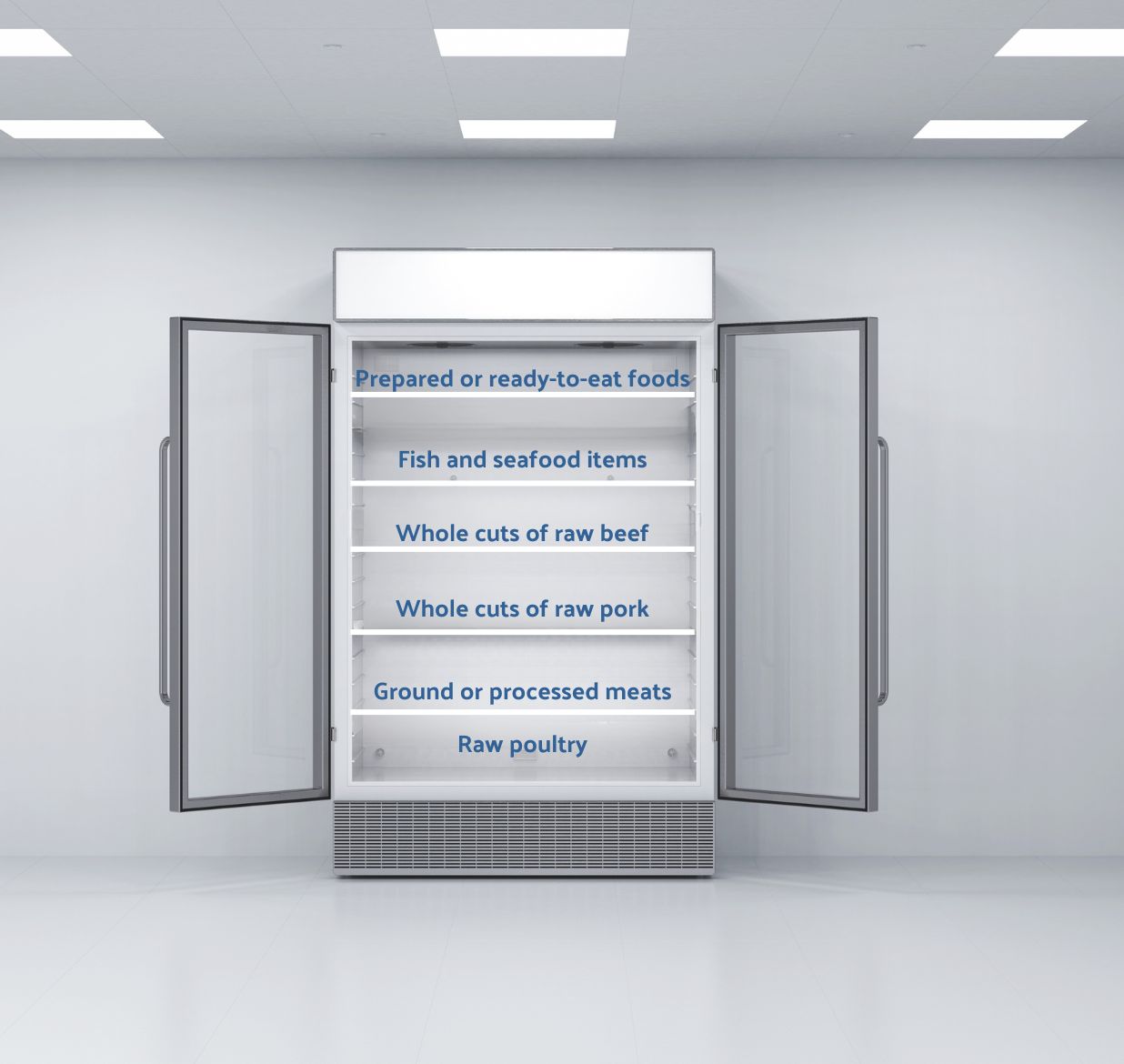
Storage upon Receiving:
Place foods into appropriate storage areas immediately upon receipt in the following order:
- Refrigerated foods: Store foods in designated refrigerators. If food products are stored together in a refrigerator, they must be placed on shelves in the order seen in the image to the left.
- Frozen foods.
- Dry foods.
Keep all food items on shelves at least six inches above the floor to facilitate air circulation and proper cleaning. Rotate goods when placing them in storage by putting the new items behind the old items to ensure that the older items are used first (First In, First Out inventory rotation).
Store food in the original container if the container is clean, dry, and intact. If necessary, repackage the food in clean, well-labeled, airtight containers. This can also be done after opening a package.
See this Ordering and Receiving SOP for more detailed procedures for purchasing and receiving practices.

Storage upon Receiving:
Place foods into appropriate storage areas immediately upon receipt in the following order:
- Refrigerated foods: Store foods in designated refrigerators. If food products are stored together in a refrigerator, they must be placed on shelves in the order seen in the image to the left.
- Frozen foods.
- Dry foods.
Keep all food items on shelves at least six inches above the floor to facilitate air circulation and proper cleaning. Rotate goods when placing them in storage by putting the new items behind the old items to ensure that the older items are used first (First In, First Out inventory rotation).
Store food in the original container if the container is clean, dry, and intact. If necessary, repackage the food in clean, well-labeled, airtight containers. This can also be done after opening a package.
See this Ordering and Receiving SOP for more detailed procedures for purchasing and receiving practices.
Safe Handling
Temperature Control
The first step to safe food handling is ensuring that all storage areas are at the proper temperature. Be sure the temperature of all refrigerators and freezers are being checked and documented appropriately on designated logs at the beginning of each day. Proper procedures should be in place outlining corrective actions if temperatures are out of the recommended range. Safe temperature zones for refrigerators and freezers are:
- Refrigerator temperatures must be between 36ºF and 41ºF.
- Deep chill storage temperatures are 32ºF or below.
- Freezer temperatures should be between -10ºF and 0ºF.
To avoid temperature fluctuations, be sure not to overload refrigerated storage areas as it prevents air flow and uses more energy to stay cold. In addition, use caution when cooling hot food in the refrigerator, as this warms the unit and could put other foods into the temperature danger zone. Inform staff to keep units closed as much as possible to maintain proper temperatures. Lastly, defrost all units on a regular schedule to aid in appropriate maintenance and air circulation.
Thawing Food
An important consideration when working with fresh, raw animal proteins is ensuring that proper thawing methods are being implemented for all frozen products when preparing to cook them to avoid any food safety hazards or foods entering the temperature danger zone. Appropriate thawing methods for fresh proteins include either thawing foods in the refrigerator at 41°F or below or thawing foods needed for immediate service under potable running water at 70°F or lower. Never thaw foods at room temperature and be sure to prepare the product within four hours of thawing.
Other safe practices include using the lowest shelf in the cooler for thawing raw meat and separating raw products from cooked and ready-to-eat products prevent cross-contamination when thawing in the refrigerator. Additionally, do not refreeze thawed foods, unless they are first cooked or processed. Discard thawed, potentially hazardous foods that have been above 41°F for more than four hours.
Hygiene
Proper hygiene is essential to a food safe environment, especially when it comes to handling fresh, raw proteins. The key is to wash hands and surfaces often and avoid any risk of cross-contamination throughout the handling process. See the list of proper procedures below:
- Wash your hands with warm water and soap for at least 20 seconds before and after handling food.
- Use one cutting board for fresh produce and a separate one for raw meat, poultry, and seafood. Different colored boards are a good way to keep track.
- Wash your cutting boards, dishes, and utensils before switching to a different protein.
- Use the wash, rinse, sanitize method to clean kitchen surfaces. Use a clean towel for each step.
- Never place cooked food on any surface that previously held raw meat, poultry, seafood, or eggs unless properly washed, rinsed, and sanitized.
- Don’t reuse marinades, breading mixtures, or spice mixtures that have been used on raw foods.
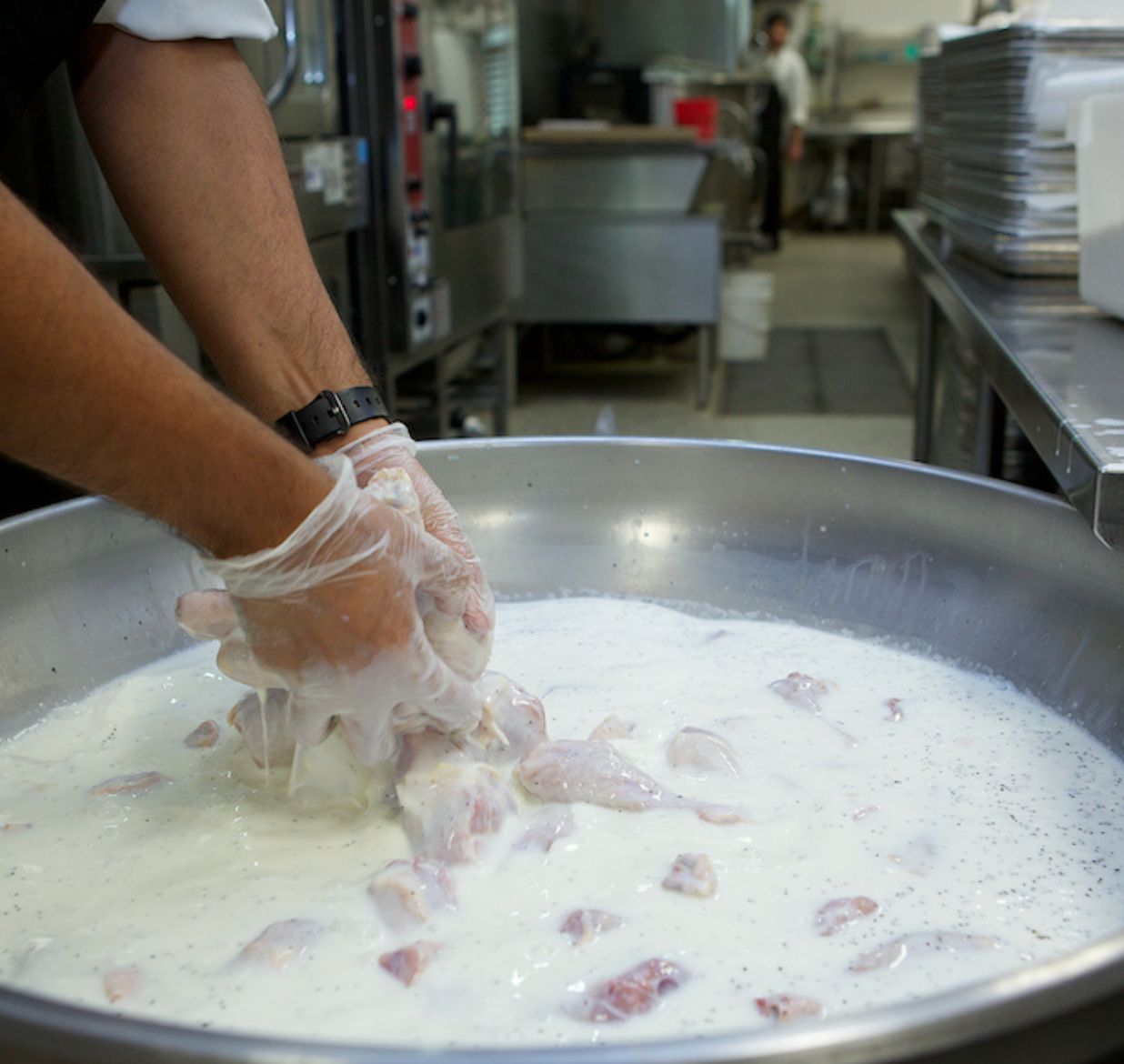

Hygiene
Proper hygiene is essential to a food safe environment, especially when it comes to handling fresh, raw proteins. The key is to wash hands and surfaces often and avoid any risk of cross-contamination throughout the handling process. See the list of proper procedures below:
- Wash your hands with warm water and soap for at least 20 seconds before and after handling food.
- Use one cutting board for fresh produce and a separate one for raw meat, poultry, and seafood. Different colored boards are a good way to keep track.
- Wash your cutting boards, dishes, and utensils before switching to a different protein.
- Use the wash, rinse, sanitize method to clean kitchen surfaces. Use a clean towel for each step.
- Never place cooked food on any surface that previously held raw meat, poultry, seafood, or eggs unless properly washed, rinsed, and sanitized.
- Don’t reuse marinades, breading mixtures, or spice mixtures that have been used on raw foods.
Cooking Fresh Animal Proteins
Using a food thermometer is the only way to ensure the safety of animal proteins for all cooking methods. These foods must be cooked to a safe minimum internal temperature to destroy harmful bacteria. Therefore, all foods are required to be cooked using appropriate practices and procedures to ensure safety, including properly cooking foods to required internal temperatures as well as taking and recording temperatures.
Employees involved in the cooking of food must complete the following steps:
- Cook hot foods to the minimum end-point temperature or higher. Avoid over-cooking.
- Take end-point cooking temperatures using a calibrated thermometer in the thickest part of the item. If the recommended temperature is not met, continue cooking until the proper temperature is reached.
- Record the end-point cooking temperature on the Cooking and Reheating Temperature Log.
- Use batch cooking to reduce the holding time of foods.
- Allow the temperature of the cooking equipment to return to the required temperatures between batches.
- Do not use hot-holding equipment to cook or reheat foods.
- Expose food ingredients to room temperature for two hours or less. Food items must be returned to cold holding as soon as possible after service. The TOTAL time of food at room temperature shall not exceed four hours.
- Prepare products that will not be cooked or heated in a different area from cooked and heated products.
Safe Minimum Internal Temperature Chart
| Product | Minimum Internal Temperature |
|---|---|
| Poultry | 165° for 15 seconds |
| Stuffing, stuffed meats, casseroles, and other dishes with both raw and cooked foods | 165° for 15 seconds |
| Ground or flaked meats | 155° for 15 seconds |
| Pork | 145° for 15 seconds |
| Beef and pork roasts | 145° for 4 minutes |
| Beef steaks, veal and lamb | 145° for 15 seconds |
| Fish and foods containing fish | 145° for 15 seconds |
| Leftovers | 165° for 15 seconds |
Cooking Methods for Specific Proteins
Ground Beef
Ground beef can remain pink inside after it is safely cooked. The pink color can be due to a reaction between heat and myoglobin, which causes a red or pink color. It can also occur when vegetables containing nitrites are cooked along with the meat. Because doneness and safety cannot be judged by color, it is very important to use a food thermometer when cooking ground beef. To be sure all harmful bacteria are destroyed, cook raw ground beef to an internal temperature of 160 °F as measured with a food thermometer.
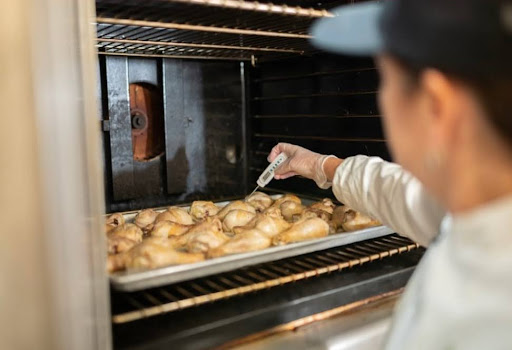
Poultry
Raw poultry can vary from bluish-white to yellow. All of these colors are normal and are derived from breed, exercise, age, or diet. Younger poultry have less fat under the skin, which can cause the bluish cast, and the yellow skin could be a result of marigolds in the feed.
Ground poultry varies in color according to the part being ground. Darker pink means more dark meat was used, and lighter pink means more white meat was included (or skin was included).

Poultry
Raw poultry can vary from bluish-white to yellow. All of these colors are normal and are derived from breed, exercise, age, or diet. Younger poultry have less fat under the skin, which can cause the bluish cast, and the yellow skin could be a result of marigolds in the feed.
Ground poultry varies in color according to the part being ground. Darker pink means more dark meat was used, and lighter pink means more white meat was included (or skin was included).
Darkening of bones and meat around the bones occurs primarily in young (6-8 weeks) broiler-fryer chickens. Since the bones have not calcified or hardened completely, pigment from the bone marrow seeps through the bones and into the surrounding area. Freezing can also contribute to this darkening. This is an aesthetic issue, not a safety one. The meat is safe to eat when all parts have reached a safe minimum internal temperature of 165 °F as measured with a food thermometer.
Safely cooked poultry can vary in color from white to pink to tan. For safety when cooking poultry, use a food thermometer to check the internal temperature. For a whole chicken or turkey, check the internal temperature in the innermost part of the thigh and wing and the thickest part of the breast. All the meat—including any that remains pink—is safe to eat as soon as all parts reach at least 165 °F when measured with a food thermometer.
Pork
Fresh pork can vary from light pink to dark purplish red depending on the cut and quality. Fresh pork should have a clean and slightly metallic smell. If it smells sour, it is starting to spoil and should be rejected on delivery.
Pork roasts should be cooked to 145°F, and ground pork should be cooked to a minimum of 155°F as measured with a food thermometer for 15 seconds. Even though it may still be pink in the center, it is safe. The pink color can be due to the cooking method or added ingredients.
Fish
Fish flesh can be ivory to pale gray to yellow depending on the species of fish. Trout and types of salmon can vary from bright red to light pink. Whole fish should have bright red gills, shiny skin, bright, clear, full eyes, and firm flesh that springs back when touched. It should be packed in self-draining ice, 41ºF or below. If the fish has dull gray gills, dull, dry skin, cloudy red-rimmed sunken eyes, strong fishy or ammonia smell, and/or any indication of thawing and refreezing at an unsafe temperature, it should be rejected.
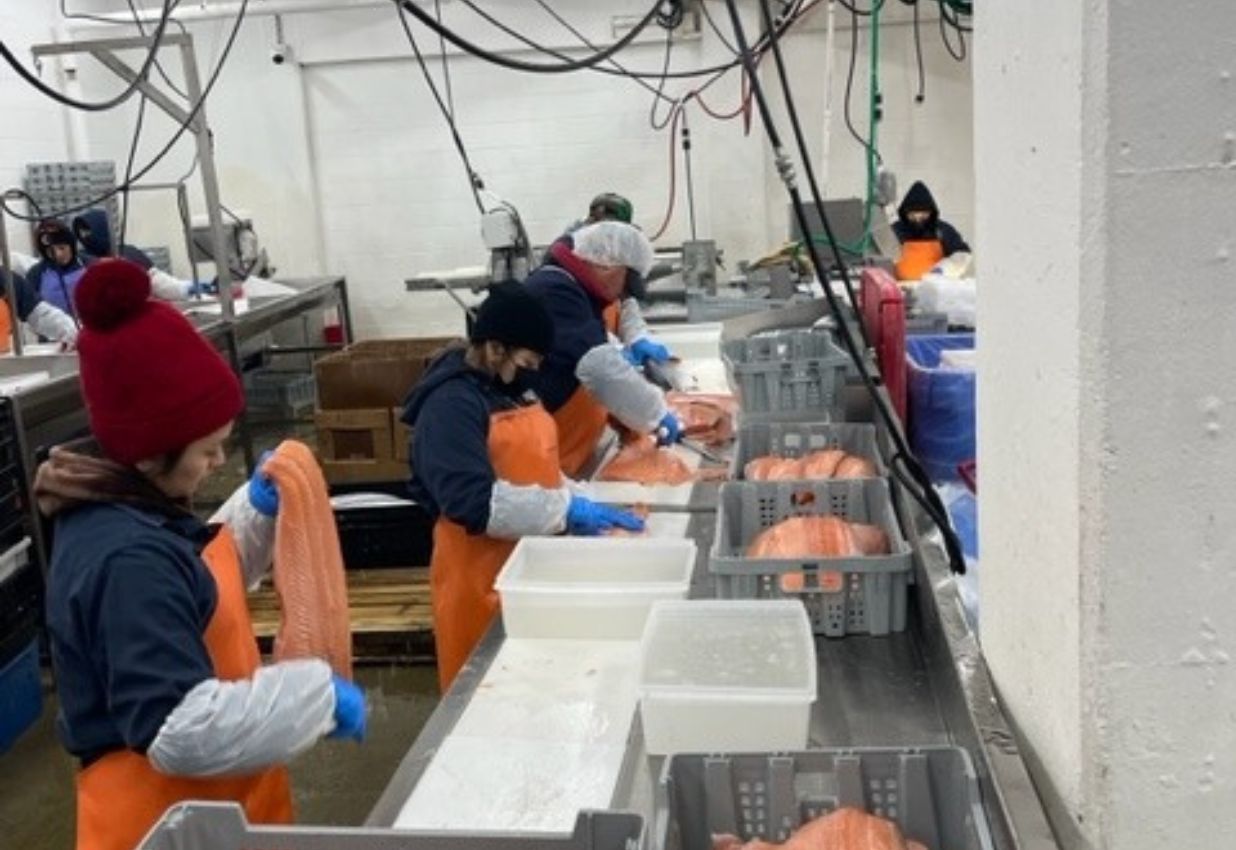

Fish
Fish flesh can be ivory to pale gray to yellow depending on the species of fish. Trout and types of salmon can vary from bright red to light pink. Whole fish should have bright red gills, shiny skin, bright, clear, full eyes, and firm flesh that springs back when touched. It should be packed in self-draining ice, 41ºF or below. If the fish has dull gray gills, dull, dry skin, cloudy red-rimmed sunken eyes, strong fishy or ammonia smell, and/or any indication of thawing and refreezing at an unsafe temperature, it should be rejected.
Fresh Eggs
Fresh eggs can be whole shells or in bulk liquid form. If procuring whole eggs, they should be clean, uncracked, and in containers that identify the source of the eggs. The source may be identified as a code on the container that usually is a letter followed by three or four numbers. Bulk liquid eggs are a more efficient product when cooking larger amounts such as sheet pan eggs or a casserole. Check with your local farmers to see if they offer bulk liquid eggs. Always check with your local health department or regulatory authority before adding Farm Fresh Eggs to your program.
Cooling
In addition to thawing and cooking, cooling also requires specific methods to ensure food safety. Cooling cooked products, either for pre-preparation or leftovers from meal service, introduces the risk of foods entering the temperature danger zone, and therefore proper procedures must be followed.
Methods for Cooling Food
First, separate food into smaller batches to cool more quickly and evenly. From here, the following methods can be used:
To use an ice water bath, place food containers in a clean prep sink or pot filled with ice water. Stir the food frequently to cool it faster and more evenly.
You can also use ice paddles. These are plastic containers that are filled with water and then frozen. Let the ice paddles sit at room temperature for a few minutes so they do not break, then place them in your hot food container and stir frequently to help cool food. You can use both methods simultaneously to cool your food more quickly. Take temperatures every 30 minutes and record them on your food cooling log.
If you are cooling in a large walk-in freezer or Blast Chiller, separate food into smaller batches using a shallow hotel or sheet pans. Place the pans on the appropriate speedrack, skipping every other level to ensure optimal airflow for cooling. If using hotel pans you may need to place those on sheet pans to fit on your rack. Leave the food at room temperature for at least 20 minutes to cool before putting it in your walk-in freezer. You do not want to put your freezer into shock and risk a rapid defrost, which would put the other food items in the freezer in danger. If using a blast chiller, the speedrack can go in immediately. Stir food and take temperatures every 30 minutes, and record on your food cooling log until the temperature is under 40°F. After cooling, cover and label the food item with the name, the date packed, and use-by date.
Check with your local regulatory agency before using this method. It may not be acceptable in your area.
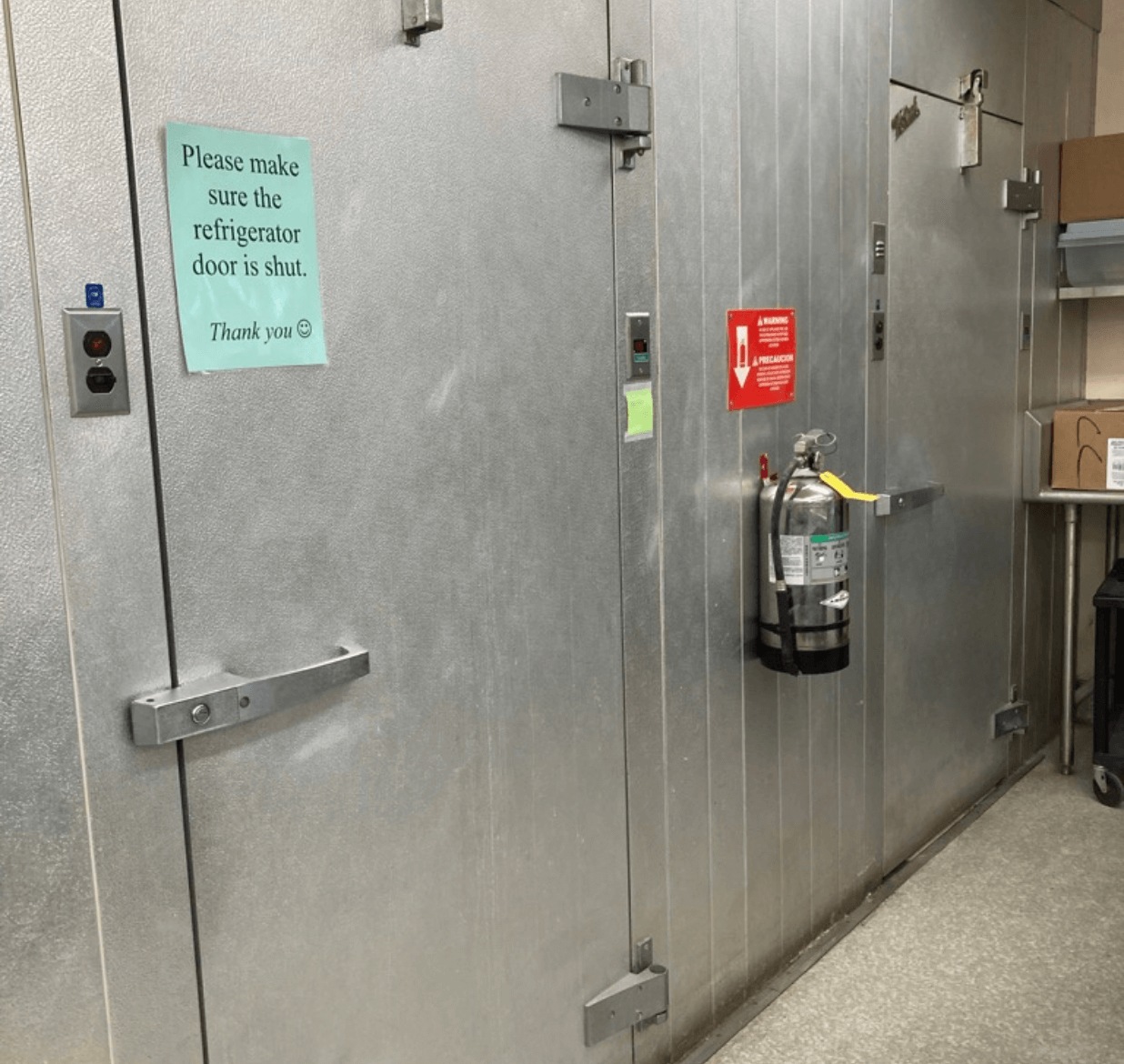
Cook/Chill Method:
When you do not serve cooked food immediately, you must get it out of the temperature danger zone as quickly as possible. That means cooling it quickly. Cool TCS food from 135°F to 41°F or lower within six hrs. Food needs to be cooled down to 70°F within two hours, then to 40°F or below in the next four hours. The total cooling time cannot exceed six hours. If you cannot get the food to cool within those temperature time-frames, it must be discarded.
Check your local regulatory requirements for verification on times and temperatures.

Cook/Chill Method:
When you do not serve cooked food immediately, you must get it out of the temperature danger zone as quickly as possible. That means cooling it quickly. Cool TCS food from 135°F to 41°F or lower within six hrs. Food needs to be cooled down to 70°F within two hours, then to 40°F or below in the next four hours. The total cooling time cannot exceed six hours. If you cannot get the food to cool within those temperature time-frames, it must be discarded.
Check your local regulatory requirements for verification on times and temperatures.
Serving Procedures
Protein serving sizes are different depending on the grade level. When writing your recipes or using USDA standardized recipes available online, it’s important to meet the minimum serving size for each grade level per service per day.

Percent Yields
The amount of protein served to students is the edible portion (EP) of the animal protein which is the weight of a product after it has been cooked. A raw protein loses weight throughout the cooking process so it is important to consider percent yields. Yields for all proteins are different and should be used to determine the edible portion of the protein from the as purchased (AP), or raw, weight of the protein. From this calculation, you will be able to estimate how much raw protein to cook in order to serve students the appropriate amount of meat needed to comply with regulations per grade level. To estimate what you need to buy to achieve the yield needed for recipes, the USDA Food Buying Guide Protein Yield Chart is a great tool. Please keep in mind they are estimates and not exact.
Serving Utensils
Making sure your serving sizes are compliant is the first step, using the correct serving utensil with the correct portion size is the other. Be sure that specific cooking and service utensils are specified in your standardized recipes to ensure accurate measuring and serving. Here are some examples of standardized recipes for different grade levels from The Lunch Box:
Serving Utensils
Making sure your serving sizes are compliant is the first step, using the correct serving utensil with the correct portion size is the other. Be sure that specific cooking and service utensils are specified in your standardized recipes to ensure accurate measuring and serving. Here are some examples of standardized recipes for different grade levels from The Lunch Box:
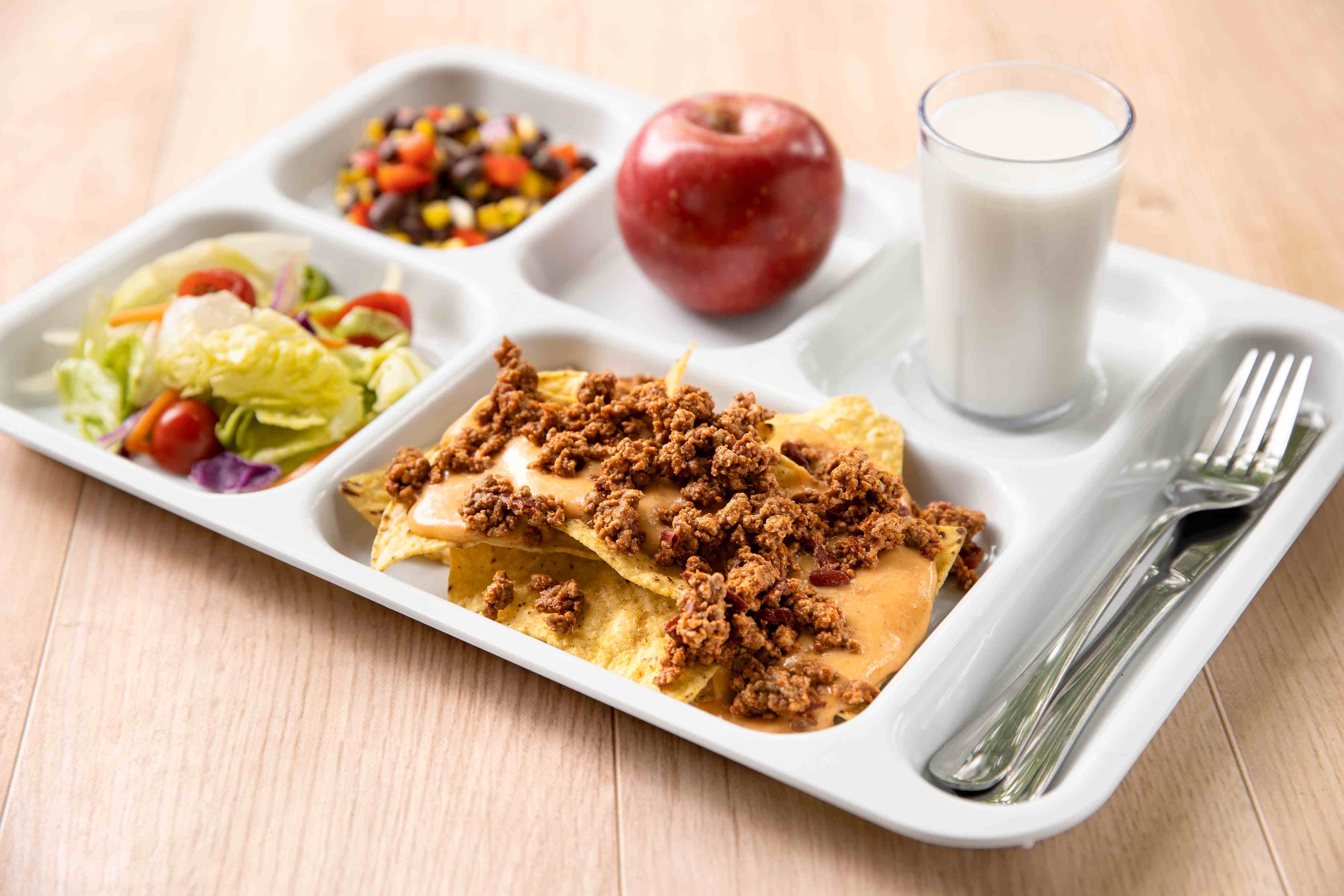

Serving Utensils
Making sure your serving sizes are compliant is the first step, using the correct serving utensil with the correct portion size is the other. Be sure that specific cooking and service utensils are specified in your standardized recipes to ensure accurate measuring and serving. Here are some examples of standardized recipes for different grade levels from The Lunch Box:
Resources
Recipes
Cooking with raw proteins can seem daunting so we encourage you to use the resources on this page and TLB’s School Recipe Database to support your scratch cooking journey. Here are a few recipe examples of each animal protein source from The Lunch Box:
Standard Operating Procedures
Here are some SOP’s for adding Fresh/Raw Proteins to your lunch program:
Recommended Next Topic: Apply for a CAF Grant
The Chef Ann Foundation offers a variety of grants for school districts. From professional development to salad bar equipment, we offer a mix of solutions and support.
Recommended Next Topic: Apply for a CAF Grant
The Chef Ann Foundation offers a variety of grants for school districts. From professional development to salad bar equipment, we offer a mix of solutions and support.















